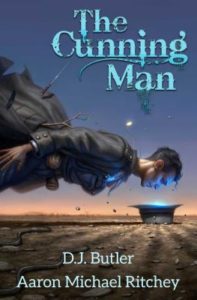On Monday I mentioned here how excited I was for the release of D. J. Butler and Aaron Michael Ritchey’s Depression-Era paranormal Mormon adventure novel, The Cunning Man.
Tuesday I came home after work to find a copy of the book on my doorstep, a month ahead of schedule, because @DavidJohnButler is a swell guy.
And boy, does the book deliver on that beautiful cover.
Hiram Woolley is a beet farmer, a WWI veteran, a widower, and the worry-worn adoptive father of a clever and creative son who’s almost ready to strike out on his own.
He’s also a somewhat reluctant practitioner of of folk magic in a world where rapid modernization makes it feel like there’s little place for old practices. But when he’s sent to deliver food to out-of-work miners, he encounters something he can’t face in any other way.
It’s pulpy, with noir and horror vibes that would fit comfortably on the pages of Weird Tales or any Depression-era dime novel. The austere landscape of Carbon County is a beautiful backdrop to the eerie and arcane.
There’s also a debt to the adventures of another fedora-wearing hero, pointed to with a wink and a nod by a scene where Hiram has to cross a field of rattlesnakes before doing some fancy work with a bullwhip.
Like Indiana Jones, Hiram straddles modernity with its trucks, trains and revolvers, and older powers he’s learned of from dusty books. Unlike Indiana Jones, Hiram is painfully aware that this knowledge will often make him uncomfortably out of place.
And he doesn’t need to travel the world to pillage the artifacts of other peoples… Hiram’s esoteric traditions are his own, common practices that were just starting to go underground a generation before.
nd it’s here that “The Cunning Man” is a deeply Mormon novel. Because a century later, it’s still working through the turn-of-the-century transformation that the first Mormon novelists responded to, as demonstrated by @ScottHales80 in his dissertation.
There’s beautiful complexity to how all of this is handled– no straightforward nostalgia for an imagined past on display here, but also genuine recognition that something is missing and that people are trying to get their bearings.
Anyway, I really enjoyed the book, for these and many other reasons. It’s a deliciously creepy tale with compelling characters facing hair-raising danger from eldritch powers and railroad bosses, which turn out to be pretty similar in the end.
If weird Mormonism strikes your fancy, pick it up. If paranormal mystery is your thing, pick it up. If US history is your thing, pick it up. Officially releases November 5th and can be pre-ordered from behemoth-retailer Amoloch or your local independent bookseller.

